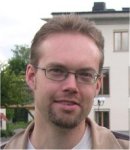|
|
|
Plenary
Lecture
Using Bioinformatics and Evolution for Understanding Functional Properties
of Microbial Enzymes

Assistant Professor Magnus
Karlsson
Swedish University of Agricultural Sciences
Forest Mycology and Pathology
P.O. 7026, SE-75007, Uppsala, Sweden
E-mail: Magnus.Karlsson@mykopat.slu.se
Abstract: Biomass such as wood, crop residues or shellfish waste can
be used as raw material for many different industrial purposes. There is a
demand for biomass-modifying enzymes with new or modified properties to be
applied in these industrial processes. Microorganisms such as bacteria and
fungi are the primary degraders of biomass in the environment and they
provide a source of enzymes with novel properties. Recent advances in DNA
sequencing technology provide the scientific community with an accelerated
number of complete microbial genome sequences that are exploited in
understanding enzyme diversity.
Chitin is a polymer of N-acetylglucosamine found in invertebrates, fungi and
zooplankton and it is the second most common biopolymer in nature, only
bypassed by cellulose. Using state-of-the-art bioinformatic techniques and
comparative genomics we have described the distribution and diversity of
microbial chitinase genes, including several subgroups that were previously
unknown and where no biochemical data are available. In addition, by
considering the evolutionary context of an organism we can interpret
molecular, genetic, genomic, proteomic or ecological data in a more
comprehensive way. We currently employ methods in evolutionary genetics to
better understand what molecular changes that is responsible for phenotypic
variation, with important applications in industry and agricultural crop
production. Studies of adaptive changes of proteins can be used to determine
the molecular changes responsible for enzyme specificity. By establishing
structure-function relationships we can address both basal scientific
questions in evolutionary biology but also applied questions concerning
protein engineering of enzymes with specific properties for agricultural and
biotechnological applications.
Brief Biography of the Speaker:
Dr. Magnus Karlsson graduated from Uppsala University in 1999 with a Master
degree in molecular biology. During the period 2000-2005 he was working in
forest pathology, studying root rot disease on forest trees, with special
focus on the molecular basis of pathogenicity and virulence. These studies
were finished with a PhD degree in Biology from the Swedish University of
Agricultural Sciences. He did his first post-doc period (2005-2006) at
Uppsala University where he was working with questions on the evolution of
reproductive systems. He continued with a second post-doc (2006-2008) where
he worked with applied and basic research concerning microbial community
structure and functioning. In 2009 he was appointed Assistant Professor in
Plant Pathology at the Swedish University of Agricultural Sciences. Current
research focuses on mechanisms of biological control of plant pathogens and
plant disease determinants.
|
|
|